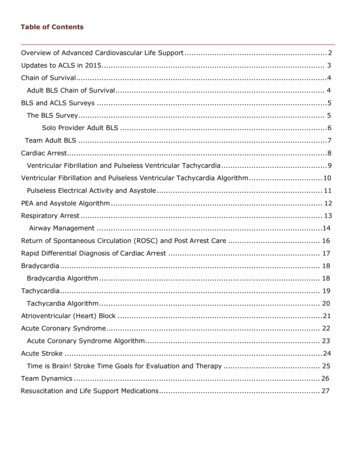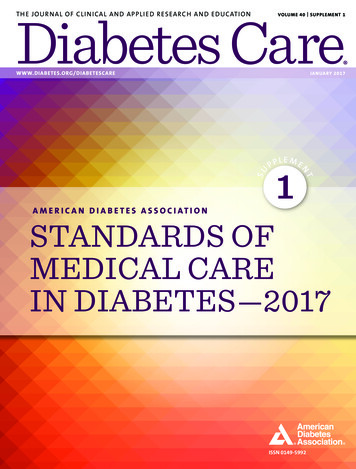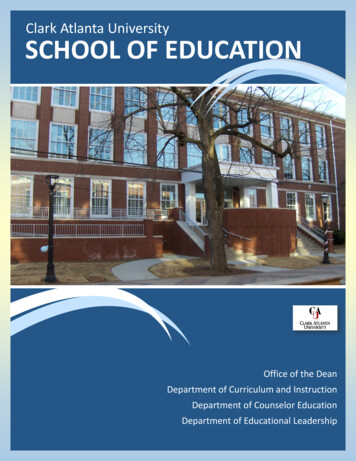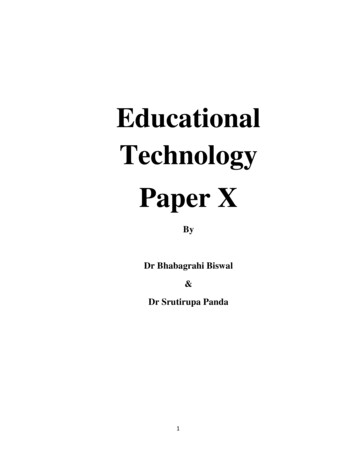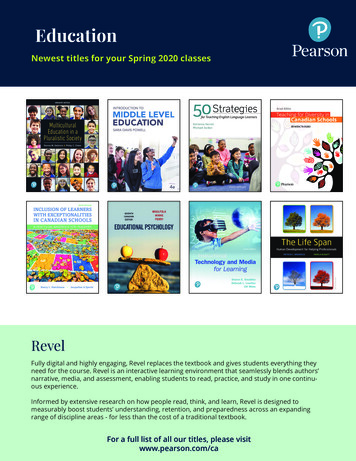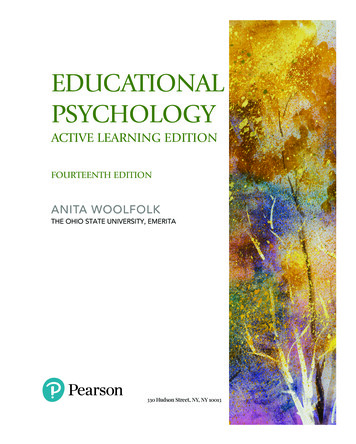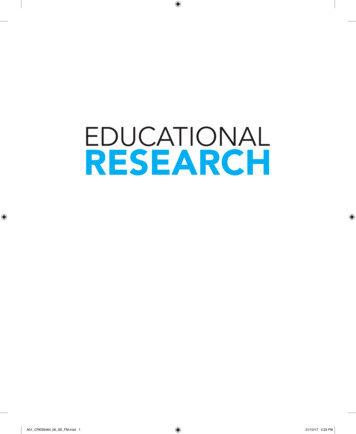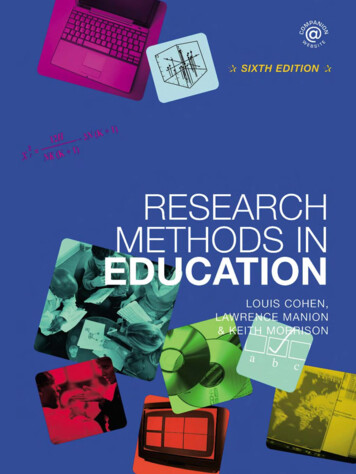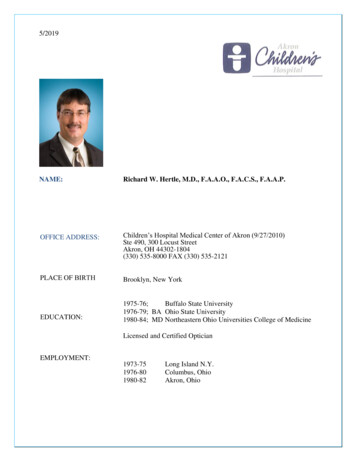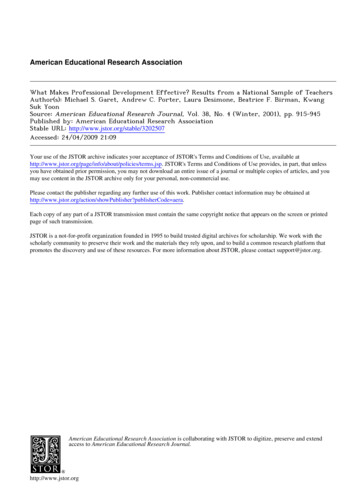
Transcription
American Educational Research AssociationWhat Makes Professional Development Effective? Results from a National Sample of TeachersAuthor(s): Michael S. Garet, Andrew C. Porter, Laura Desimone, Beatrice F. Birman, KwangSuk YoonSource: American Educational Research Journal, Vol. 38, No. 4 (Winter, 2001), pp. 915-945Published by: American Educational Research AssociationStable URL: http://www.jstor.org/stable/3202507Accessed: 24/04/2009 21:09Your use of the JSTOR archive indicates your acceptance of JSTOR's Terms and Conditions of Use, available rms.jsp. JSTOR's Terms and Conditions of Use provides, in part, that unlessyou have obtained prior permission, you may not download an entire issue of a journal or multiple copies of articles, and youmay use content in the JSTOR archive only for your personal, non-commercial use.Please contact the publisher regarding any further use of this work. Publisher contact information may be obtained herCode aera.Each copy of any part of a JSTOR transmission must contain the same copyright notice that appears on the screen or printedpage of such transmission.JSTOR is a not-for-profit organization founded in 1995 to build trusted digital archives for scholarship. We work with thescholarly community to preserve their work and the materials they rely upon, and to build a common research platform thatpromotes the discovery and use of these resources. For more information about JSTOR, please contact support@jstor.org.American Educational Research Association is collaborating with JSTOR to digitize, preserve and extendaccess to American Educational Research Journal.http://www.jstor.org
American Educational ResearchJournalWinter 2001, Vol. 38, No. 4, pp. 915-945What Makes Professional DevelopmentEffective? Results From a National Sampleof TeachersMichael S. GaretAmerican Institutes for ResearchAndrew C. PorterUniversity of Wisconsin, MadisonLaura DesimoneVanderbilt UniversityBeatrice F. BirmanAmerican Institutes for ResearchKwang Suk YoonAmerican Institutes for ResearchThis study uses a national probability sample of 1,027 mathematics andscience teachers to provide the first large-scale empirical comparison of effects of different characteristics of professional development on teachers'learning. Results, based on ordinary least squares regression, indicate threeMICHAELS. GARET is Chief Research Scientist, American Institutes for Research,1000 Thomas Jefferson St., NW, Washington, DC 20007. His specializations are quantitative research methods, educational organizations, and education reform.ANDREWC. PORTERis Director, Wisconsin Center for Education Research, andProfessor of Educational Psychology, University of Wisconsin, Madison, WisconsinCenter for Education Research, 1025 W. Johnson St., Madison, WI 53706. His specializations are research on teaching, policy, and assessments.is Assistant Professor of Public Policy and Education, VanderbiltDESIMONELAURAUniversity, Peabody College, Rm 210E, Nashville, TN 37203. Her specializations areeducation reform and program evaluation.is Managing Research Scientist, American Institutes for ReBEATRICEF. BIRMANsearch, 1000 Thomas Jefferson St., NW, Washington, DC 20007. Her specializationsare evaluation of education programs, education policy, and sociology of education.KWANGSUK YOONis a Senior Research Scientist, American Institutes for Research,1000 Thomas Jefferson St., NW, Washington, DC 20007. His specializations are motivation and lifelong learning, longitudinal research methods, and programevaluation.
Garet et al.core features of professional development activities that have significant,positive effects on teachers' self-reported increases in knowledge and skillsand changes in classroom practice: (a) focus on content knowledge; (b)opportunities for active learning; and (c) coherence with other learningactivities. It is primarily through these core features that thefollowing structuralfeatures significantly affect teacher learning: (a) the form of the activity (e.g., workshop vs. study group); (b) collectiveparticipation of teachersfrom the same school, grade, or subject; and (c) the duration of the activity.n recent years, national, state, and local policymakers and educators havelaunched efforts to improve education by creating a fundamental shift inwhat children learn and how they are taught. If children are to achieve atlevels demanded by the high standardsthat states and districtshave adopted,however, teachers will have to help them do so. Teachers are necessarily atthe center of reform, for they must carry out the demands of high standardsin the classroom (Cuban, 1990). Thus, the success of ambitious educationreform initiatives hinges, in large part, on the qualifications and effectivenessof teachers. As a result, teacher professional development is a major focus ofsystemic reform initiatives (Corcoran, 1995; Corcoran, Shields, & Zucker,1998).To carry out the demands of education reform, teachers must be immersed in the subjects they teach, and have the ability both to communicatebasic knowledge and to develop advanced thinking and problem-solvingskills among their students (Loucks-Horsley, Hewson, Love, & Stiles, 1998;National Commission on Teaching and America's Future, 1996). The centralelements of systemic reform-high standards, curriculum frameworks, andnew approaches to assessment aligned to those standards-generate newexpectations for teachers' classroom behaviors, as well as for student performance (Bybee, 1993; National Council of Teachers of Mathematics, 1991;National Research Council, 1996; Webb & Romberg, 1994).However, although teachers generally support high standards for teaching and learning, many teachers are not prepared to implement teachingpractices based on high standards (Cohen, 1990; Elmore & Burney, 1996;Elmore, Peterson, & McCarthey,1996; Grant,Peterson, & Shojgreen-Downer,1996; Sizer, 1992). Many teachers learned to teach using a model of teachingand learning that focuses heavily on memorizing facts, without also emphasizing deeper understanding of subject knowledge (Cohen, McLaughlin,&Talbert, 1993; Darling-Hammond & McLaughlin, 1995; Porter & Brophy,1988). Shifting to a more balanced approach to teaching, which places moreemphasis on understanding subject matter, means that teachers must learnmore about the subjects they teach, and how students learn these subjects.The continual deepening of knowledge and skills is an integral part of anyprofession. Teaching is no exception (Shulman & Sparks, 1992; NationalBoard for Professional Teaching Standards, 1989).916
What Makes Professional Development Effective?Defining High-Quality Professional DevelopmentDuring the past decade, a considerable body of literature has emerged onprofessional development, teacher learning, and teacher change.1 The research literature contains a mix of large- and small-scale studies, includingintensive case studies of classroom teaching, evaluations of specific approaches to improving teaching and learning, and surveys of teachers abouttheir preservice preparation and in-service professional development experiences.2 In addition, there is a large literature describing "best practices" inprofessional development, drawing on expert experiences. Despite the sizeof the body of literature, however, relatively little systematic research hasbeen conducted on the effects of professional development on improvements in teaching or on student outcomes.Although relatively little research has been conducted on the effects ofalternative forms of professional development, the research that has beenconducted, along with the experience of expert practitioners, provides somepreliminary guidance about the characteristics of high-quality professionaldevelopment (see, in particular, Loucks-Horsley, Hewson, Love, & Stiles,1998). For example, James Hiebert, in a review of the research on mathematics teaching and learning conducted for the National Council of Teachers of Mathematics, calls attention to the importance of high standards,content focus, and in-depth learning opportunities for teachers. According toHiebert,Research on teacher learning shows that fruitful opportunities tolearn new teaching methods share several core features: (a) ongoing(measured in years) collaboration of teachers for purposes of planning with (b) the explicit goal of improving students' achievement ofclear learning goals, (c) anchored by attention to students' thinking,the curriculum, and pedagogy, with (d) access to alternative ideasand methods and opportunities to observe these in action and toreflect on the reasons for their effectiveness . (1999, p. 15)Although lists of characteristics such as these commonly appear in theliterature on effective professional development, there is little direct evidence on the extent to which these characteristics relate to positive outcomes for teachers and students. Some studies conducted over the pastdecade suggest that professional development experiences that share all ormost of these characteristics can have a substantial, positive influence onteachers' classroom practice and student achievement.3 Several recent studies have begun to examine the importance of specific characteristics ofprofessional development. For example, a number of recent studies suggestthat the duration of professional development is related to the depth ofteacher change (Shields, Marsh, & Adelman, 1998; Weiss, Montgomery, Ridgway, & Bond, 1998). Furthermore, there is some indication that professionaldevelopment that focuses on specific mathematics and science content andthe ways students learn such content is especially helpful, particularly for917
Garet et al.instruction designed to improve students' conceptual understanding (Cohen& Hill, 1998; Fennema et al., 1996). However, although some researchers arebeginning to examine the effects of professional development on teachingand learning, few studies have explicitly compared the effects of differentcharacteristics of professional development.4Thus, there is a clear need tor new, systematic research on the effectiveness of alternative strategies for professional development. The NationalResearch Council, for example, in a review of recent research on the cognitive sciences. teaching, and learning, argues thatResearchstudies are needed to determinethe efficacy of varioustypes of viceand in-serviceseminars,workshops,and evelopmentactivitiesthatareextendedover time and acrossbroadteacherlearningcommunitiesin ordertoidentifythe processesand mechanismsthatcontributeto the development of teachers'learningcommunities.(Bransford,Brown, &Cocking, 1999, p. 240)Study DesignIn this paper we draw on data collected as part of a national evaluation of theEisenhower Professional Development Program, a federal program whichsupports professional development for teachers, mainly in mathematics andscience. We designed this study to enable us to examine the relationshipbetween features of professional development that have been identified inthe literatureand self-reported change in teachers' knowledge and skills andclassroom teaching practices. We integrated and operationalized the ideas inthe literatureon "best practices"in professional development to create a setof scales describing the characteristics of activities assisted by the Eisenhower program, then empirically tested these characteristicsto examine theireffects on teacher outcomes.Data SourcesFor the analyses in this study, we use data from a Teacher Activity Surveyconducted as part of the national evaluation of the Eisenhower ProfessionalDevelopment Program.The program, Title II of the Elementary and Secondary Education Act (ESEA),is the federal government's largest investment thatis solely focused on developing the knowledge and skills of classroom teachers. Part B of the Eisenhower program, with a 1999 appropriation of about 335 million, provides funds through state education agencies (SEAs) toschool districts, and through state agencies for higher education (SAHEs) tograntees: SAHEgrantees include institutions of higher education (IHEs) suchas universities, 4-year colleges, or 2-year colleges, and not-for-profits(NPOs), which are organizations such as zoos, museums, and libraries.918
What Makes Professional Development Effective?These funds primarilysupport professional development in mathematics andscience.5The Eisenhower program is a source of funding for professional development activities, not a specific approach to professional development. Theprogram allows support for activities that are wide-ranging and includeworkshops and conferences, study groups, professional networks and collaboratives, task force work, and peer coaching. Furthermore, Eisenhowerfunding does not exist in a vacuum. Professional development activitiesassisted by funding from the Eisenhower program (or "Eisenhower-assisted"activities) also may receive funding through states, school districts, and otherfederal programs. Therefore, this study about the effects of Eisenhowerassisted activities on teacher outcomes also is applicable to professionaldevelopment funded through other sources.In the spring, summer, and fall of 1998, we surveyed a nationally representative sample of teachers who had attended Eisenhower-assisted activities over the period from July 1 through December 31, 1997. We carriedout the survey by drawing a national probability sample of school districtsand SAHE grantees receiving Eisenhower funds. Districts were sampled inproportion to the number of teachers in the district, and SAHEgrantees weresampled in proportion to the size of their Eisenhower grant, based on thelogic that SAHEgrantees with larger grants would serve larger numbers ofteachers.6 For each district and SAHE grantee drawn into the sample, wecollected a complete list of all professional development activities conductedwith Eisenhower funds over the period from July through December, 1997.We then drew a sample of two activities in each district or SAHE grantee,with probability proportional to the number of teachers attending the activity. We then randomly subsampled two teachers who attended each activity.We received responses from 1,027 teachers, representing activities supported by Eisenhower funds in 358 districts and SAHE grantees. This produced an overall teacher response rate of 72%.7 The survey asked eachteacher to provide detailed information about the specific Eisenhowerassisted professional development activity that we drew in our samplingprocess and that led the teacher to be selected for our sample. Responses areself-reports of teacher experiences and behavior.MeasuresOn the basis of the research on high-quality professional development, ouranalysis of the characteristicsof professional development focuses on "structural features"-characteristics of the structure or design of professional development activities; and "core features"-dimensions of the substance orcore of the professional development experience. We include three structural features in our model: (a) the form of the activity (i.e., whether it is areform type, such as a study group or network, in contrast to a traditionalworkshop or conference); (b) the duration of the activity, including the total919
Garet et al.number of contact hours that participantsspend in the activity, as well as thespan of time over which the activity takes place; and (c) the degree to whichthe activity emphasizes the collective participation of groups of teachersfrom the same school, department, or grade level, as opposed to the participation of individual teachers from many schools. We also examine threecore features of professional development activities: (a) the degree to whichthe activity has a content focus (that is, the degree to which the activity isfocused on improving and deepening teachers' content knowledge in mathematics and science); (b) the extent to which the activity offers opportunitiesfor active learning, such as opportunities for teachers to become activelyengaged in the meaningful analysis of teaching and learning (for example,by reviewing student work or obtaining feedback on their teaching); and (c)the degree to which the activity promotes coherence in teachers' professionaldevelopment, by incorporating experiences that are consistent with teachers'goals and aligned with state standards and assessments, and by encouragingcontinuing professional communication among teachers. The teacher outcomes that we measure are self-reported increases in knowledge and skillsin several different areas (e.g., use of technology, instructional methods,approaches to assessment), and changes in classroom practice. Below webriefly review the research in each of these areas, and provide more detaileddescriptions of the measures used in our analysis.StructuralFeaturesType of activity. Undoubtedly the most common type of professionaldevelopment, and the form most criticized in the literature, is the "workshop." A workshop is a structured approach to professional developmentthat occurs outside the teacher's own classroom. It generally involves aleader or leaders with special expertise and participantswho attend sessionsat scheduled times-often after school, on the weekend, or during the summer (Loucks-Horsley, Hewson, Love, & Stiles, 1998, pp. 42-43). Institutes,courses, and conferences are other traditional forms of professional development that share many of the features of workshops, in that they tend totake place outside of the teacher's school or classroom; and they involve aleader or leaders with special expertise and participantswho attend at scheduled times.Although traditional forms of professional development are quite common, they are widely criticized as being ineffective in providing teacherswith sufficient time, activities, and content necessary for increasing teacher'sknowledge and fostering meaningful changes in their classroom practice(Loucks-Horsley, Hewson, Love, & Stiles, 1998). As a result, there is growinginterest in "reform"types of professional development, such as study groupsor mentoring and coaching. These reform types differ from traditional professional development in several respects. In particular, reform activitiesoften take place during the regular school day. In fact, some reform activities,920
What Makes Professional Development Effective?such as mentoring and coaching, take place, at least in part, during theprocess of classroom instruction or during regularly scheduled teacher planning time. By locating opportunities for professional development within ateacher's regular work day, reform types of professional development maybe more likely than traditional forms to make connections with classroomteaching, and they may be easier to sustain over time.In addition, reform types of activities may be more responsive to howteachers learn (Ball, 1996), and may have more influence on changing teaching practice (Darling-Hammond, 1995, 1996; Hargreaves & Fullan, 1992;Little, 1993; Richardson, 1994; Sparks & Loucks-Horsley, 1989; Stiles, LoucksHorsley, & Hewson, 1996). Furthermore, Darling-Hammond (1997) arguesthat these types of activities may be more responsive to teachers' needs andgoals.Some schools have begun to create new models of induction (i.e.,support for new teachers) and ongoing professional development for teachers and principals. These models feature mentoring for beginners and veterans: peer observation and coaching; local study groups and networks fordeveloping teaching within specific subject matter areas (e.g., the NationalWritingProject or the Urban MathematicsCollaboratives);teacher academiesthat offer ongoing seminars and courses of study tied to practice; schooluniversity partnerships that sponsor collaborative research, interschool visitations; and a variety of formal and informal learning opportunitiesdeveloped in response to teachers' and principals' felt needs (DarlingHammond, 1997, p. 325).In our survey of teachers, we asked each teacher to describe the specified Eisenhower-assisted activity in which the teacher participated, and, aspart of the description, we asked the teacher to specify the type of activityand offered a choice of 10 categories.8 We coded the first four categories(within-district workshops, courses for college credit, out-of-district workshops, and out-of-district conferences) as traditional forms of activities, andthe remaining six categories (teacher study groups, teacher collaboratives ornetworks, committees, mentoring, internships, and resource centers) as reform types of activities.9The type of activity may set the context for many other features of theactivity's structure and its substance. Because reform activities such as studygroups and mentoring often take place during the regular school day, theymay enable activities of longer duration than traditional activities; and theymay make it easier to encourage the collective participation of groups ofteachers from the same school or department. Given the potential importance of activity type as a key structuralfeature, we contrast traditional andreform activities.Duration. Almost all of the recent literature on teacher learning andprofessional development calls for professional development that is sustained over time. The duration of professional development activities isexpected to be important in two ways. First, longer activities are more likelyto provide an opportunity for in-depth discussion of content, student con921
Garet et al.ceptions and misconceptions, and pedagogical strategies. Second, activitiesthat extend over time are more likely to allow teachers to try out newpractices in the classroom and obtain feedback on their teaching.On our Teacher Activity Survey we asked about two aspects of duration:the total number of contact hours spent in the professional developmentactivity, including all components of the activity that were held during the1-year period from July 1, 1997, through June 30, 1998; and the span orperiod of time, in days, weeks, and months, over which the activity wasspread.10 Although hours and span are correlated (r .41), they measuredifferent aspects of duration, both of which are potentially important inproviding teachers with sufficient opportunities for in-depth study, interaction, and reflection.Collectiveparticipation. There is a growing interest in professional development that is designed for groups of teachers from the same school,department, or grade level. Professional development designed for groups ofteachers has a number of potential advantages. First, teachers who worktogether are more likely to have the opportunity to discuss concepts, skills,and problems that arise during their professional development experiences.Second, teachers who are from the same school, department, or grade arelikely to share common curriculum materials, course offerings, and assessment requirements. By engaging in joint professional development, theymay be able to integrate what they learn with other aspects of their instructional context. Third, teachers who share the same students can discussstudents' needs across classes and grade levels.Finally, by focusing on a group of teachers from the same school,professional development may help sustain changes in practice over time, assome teachers leave the school's teaching force and other new teachers jointhe faculty. Professional development may help contribute to a shared professional culture, in which teachers in a school or teachers who teach thesame grade or subject develop a common understanding of instructionalgoals, methods, problems, and solutions. (See, for example, Talbert &McLaughlin,1993.) Collective participation in the same activity can providea forum for debate and improving understanding, which increases teachers'capacity to grow (Ball, 1996). Furthermore, Knapp (1997) emphasizes thatchange in classroom teaching is a problem of individual learning as well asorganizational learning, and that organizational routines and establishing aculture supportive of reforminstructioncan facilitateindividualchange efforts.Little research is available on the effects of collective approaches toprofessional development, but there is some evidence that it can be effectivein changing teaching practice. Newmann and associates, in a study of 24"restructuringschools," note that, in the more successful schools:Professionaldevelopmenttended to be focused on groupsof teachers withinthe school or the facultyas a whole. Makinguse of internalas well as externalexpertise,staffdevelopmentactivitiestook advantage of local skillsand sharingof effectivepractice.Includinginternal922
What Makes Professional Development Effective?expertsas staffdevelopersreinforcedteachers'sense of commitmentto theirschool'sgoals. (Newmann& Associates,1996)To measure the construct of "collective participation" in professionaldevelopment, we asked each teacher in our national sample to indicatewhether the activity in which the teacher participated was designed for allteachers in a school or set of schools, or all teachers in the teacher's department or grade level.1'Core FeaturesFocusing on content. Although there is a large body of literature onprofessional development, surprisingly little attention has been given towhat teachers actually learn in professional development activities, that is,their content. In particular,little research has been conducted on the relativeefficacy of professional development activities that focus on different typesof knowledge, skills, and teaching practices.12The available descriptive research suggests that the content coveredduring professional development activities varies along at least four dimensions. First, activities vary in the relative emphasis they give to the subjectmatter that teachers are expected to teach and the teaching methods teachersare expected to employ. Some activities are intended primarily to improveteachers' knowledge of subject-matter content; some are designed to improve general pedagogy or teaching practices, such as classroom management, lesson planning, or grouping methods; and some are intended toimprove what Shulman (1987) has termed "pedagogical content knowledge"-teaching practices in specific content domains, such as teaching multidigit addition in elementary mathematics or forces and motion in physics.Activities also vary in the specificity of the changes in teaching practicethat are encouraged. Some activities focus on helping teachers use particularcurriculum materials (e.g., new textbooks, science kits, or curriculum replacement units) or prescribed teaching strategies (e.g., specific studentquestioning strategies). Others focus on general principles, giving less attention to specific curriculaor strategies (see Kennedy, 1998, for a discussionof this distinction).In addition, activities vary in the goals for student learning that theyemphasize. Some activities emphasize helping teachers improve student performance in the basic skills; for example, memorizing facts and masteringprocedural skills, such as long division or solving linear equations with oneunknown. Other activities focus on helping teachers improve students' conceptual understanding; for example, the ability to explain the reasons behinda solution strategy.13Finally, activities vary in the emphasis they give to the ways studentslearn particularsubject matter. Some activities give considerable emphasis toimproving teachers' understanding of how children learn, by focusing, for923
Garet et al.example, on common student preconceptions, misconceptions, and solutionstrategies in specific subject domains. Other activities focus primarilyon newcurricula or teaching methods, while giving little attention to the ways students learn.Although there is little evidence on the relative effectiveness of professional development activities that focus on learning different types of knowledge, skills, and teaching practices, a small literature has begun to emergefocusing on these issues. In particular,an emerging body of work suggeststhat professional development that focuses on subject-matter content andhow children learn it may be an especially important element in changingteaching practice (e.g., Corcoran, 1995). In part, researchers base this argument on the fact that many teachers lack strong content-specific teachingskills. Reynolds, for example, in a review of the knowledge base for elementary school teachers, concluded that "beginning teachers have surprisinglyfew content-specific pedagogical understandings" (1995, p. 214). Rhine(1998), in a discussion of the role of research in teaching, pointed out that"[r]eform-mindedteachers are hungry for continuing education that providesnovel ways to address content" (p. 27).A number of authors argue that professional development requires adual focus on both knowledge of subject matter content and an understanding of how children learn specific content. Hiebert et al. (1996), for example,argue that teaching for understanding in mathematics requires two forms ofknowledge:. knowledgeof the subjectto select tasksthatencouragestudentsto wrestle with key ideas and knowledge of 'experienceandforwhichstudentscan see the relevanceof the ideas and skills they alreadypossess.(p. 16)This point of view is bolstered by several recent studies of the effects ofprofessional development on student achievement. Cohen and Hill (1998)conducted a study of mathematics teaching in California,based on data onteachers' professional development experiences and school-level data onstudent performance on a mathematics test administered statewide. Theyfound that, controlling for the characteristics
MICHAEL S. GARET is Chief Research Scientist, American Institutes for Research, 1000 Thomas Jefferson St., NW, Washington, DC 20007. His specializations are quan- titative research methods, educational organizations, and education reform. ANDREW C. PORTER is Director, Wisconsin Center for Education Research, and

